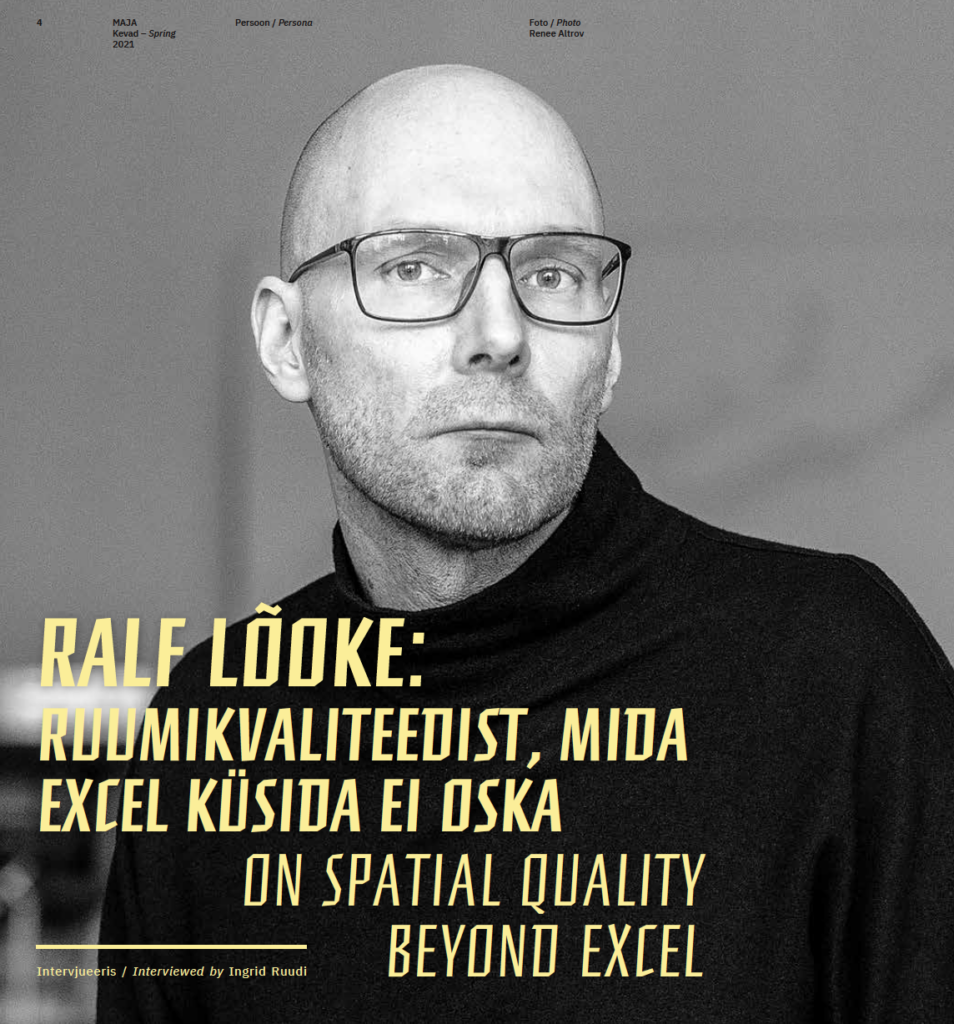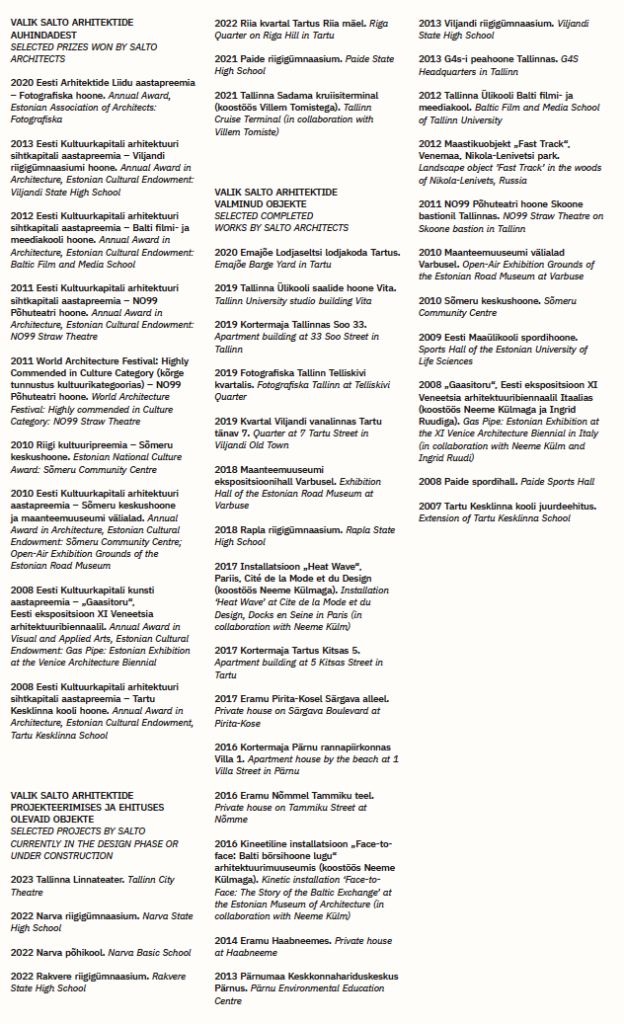
Questions by Ingrid Ruudi.
Ralf Lõoke, one of the founders of the Salto architectural office, has been among the most successful of Estonian architects for probably the past fifteen years. Salto’s capacity is impressive, ranging from large public buildings, apartment blocks and private houses to critical exhibition projects and urban installations. All these projects are interconnected by a fastidious contextual sensibility and express dialogue between the landscape and the broader urban spatial environment as well as the social and historical nuances that impact on their spatial design. As a second-generation architect, Ralf says he entertains no illusions pertaining to the specialty—a claim that makes the consistency with which he stands behind the survival of the core architectural idea throughout the design process all the more remarkable. It is being an architect that defines all of his pursuits and philosophies from work to travel, apart from perhaps music, which intermittently manages to attract an equal level of attention.
You graduated from the Estonian Academy of Arts almost twenty years ago and founded Salto right after that. Your office became successful right from the start with the very first works and have maintained a fairly steady place at the top of the Estonian architectural community ever since. How have you been able to sustain that quality? Does the Salto that we know of today differ from the one from ten-fifteen years ago in design principles or work methods?
In the early days, there used to be no routine, everyone was young and there were no time limits. Some days we would work through the night and follow that with a day off. By now, we have learned to work even on competition entries on a 10-to-6 schedule. It does not really work for me, but I manage.
The strength of the team is another thing that distinguishes the current version of Salto from the earlier one. That really makes a big difference. No doubt, we are more aware of our decision-making principles, we will not even take on certain kinds of projects or competitions. Ideation does not take much time; most time is spent on rooting out ideas that would not work—time management as a resource becomes available only as you become better at early detection and weeding out of concepts that you know will not work in reality. At the same time, being ‘too professional’ can be dangerous because it automatically diminishes the experimental aspect and cuts down on exciting ideas that might bring in new qualities of spatial thought.
For an outsider, it is probably rather hard to imagine exactly how slow the working mechanisms of an architectural consultancy are. We actually went through a wane period, but the results of such periods become visible to the public later. For instance, in 2005, 90% of our competition entries were awarded, but in 2011, which may have seemed like one of our most successful years ever, that ratio was just 15%, I think, and the result of our having come to a certain halt did not become apparent until 2014.
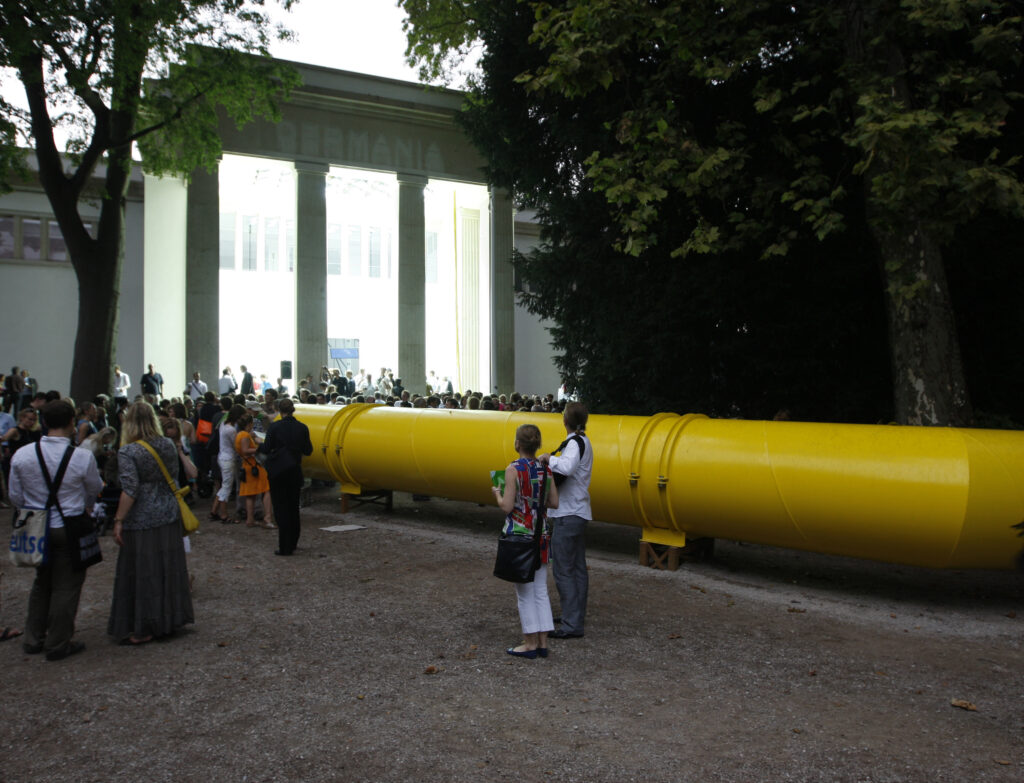
Has the process of participating in competitions changed?
We partake in competitions with a smaller team, it is either just Maarja and me or someone third as well, but to me it makes no sense to go at it with a large group. After all, the main purpose of a competition is ideation, while requirements in the brief should not exceed those that sufficiently convey the concept to the members of the jury. Unfortunately, competition briefs require specification at an increasing level of knick-knacks such as outdoor furniture, luminaires, trash bins and the like, which do not actually influence the architectural concept. Decisions at that level would be much better off if left for a later stage in the design process where there is more time to focus on them. As a jury member, you do not really look at such details, it is the idea that you are judging—does the layout work and is the proposed plan realistic and feasible without reductions in its spatial value in later design stages.

What is the recipe for competition wins? It has been noted that similar solutions start popping up elsewhere after Salto has bagged yet another win—do you identify yourselves as trendsetters?
No, we don’t! We are not trendy at all; we don’t care about that in the slightest. At any rate, any trend is sure to have passed by the time the house is completed. Your main goal in the design process is to keep yourself engaged and if something becomes annoying, you have to try another strategy. Seeing the bigger picture is paramount in architecture, and planning should not come down to calculations of how you can be extra smart about hustling more floor area for the client, or find a drippingly positive, simple and cost-effective answer to every single problem. I rather think we tend toward the minority in the architectural community in terms of our beliefs.
After all, the main purpose of a competition is ideation, while requirements in the brief should not exceed those that sufficiently convey the concept to the members of the jury. Unfortunately, competition briefs require specification at an increasing level of knick-knacks such as outdoor furniture, luminaires, trash bins and the like, which do not actually influence the architectural concept.

You were a student at a time when there was great emphasis placed on urban scale, planning and social considerations, I believe graduates from a year earlier were even called the course of city architects. Salto has not taken part in (urban) planning much, yet often through single house projects you have attempted to solve planning-related or urban spatial problems by engaging with the environment more broadly than the confined borders of the building lot would otherwise allow.
It is true that with every project we devise ways for the designed building to draw from its environment everything that it possibly can and always give back something which is not prescribed by its primary function. We are fascinated by a certain sense of totality in our designs where the building and landscape solutions are inseparable, and the interior design is an integrative part of the design as well. At the same time some of our projects are hybrids of planning and housing design, for instance, in the Old Town of Viljandi or in the Riga quarter in Tartu.

By virtue of establishing its presence within an environment, architecture also extends its sphere of influence into society. We have tried to raise various issues and take stands specifically through architectural design. Aiming at social relevance does not necessarily mean verbal output; there are plenty of people who speak and write better than I do. I still believe in the expressive potential of architecture.
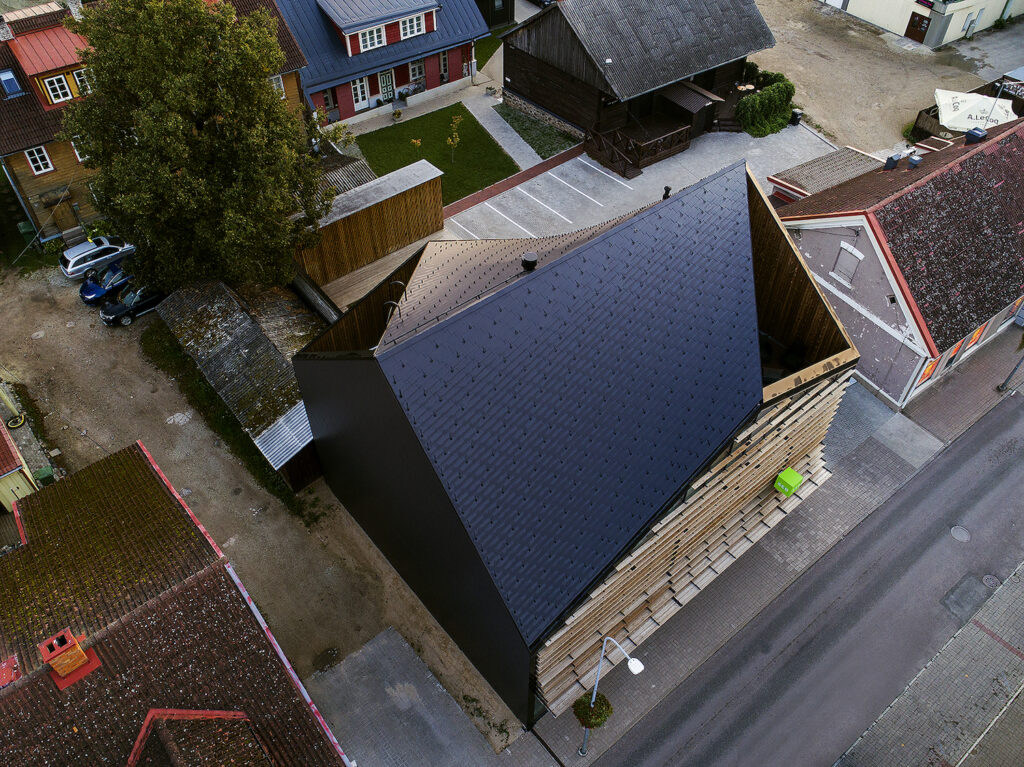
Taking a stance through built architecture must require a great deal of patience, considering the lengthy nature of the processes.
Of course, it takes a lot of time. At the same time, it is a privilege to win a competition and get to create something in the real world which you would otherwise maybe only get to make in an exhibition hall or as an installation. A competition win opens up entirely new scales and resources for a project, which makes ten-year dedication to a project acceptable. What matters is the added value that the buildings bring to the surrounding environment and how well that has been integrated into the function of the building. I am really annoyed when buildings are approached with a bluntly functional mindset and enlivening a given area is left up to installations or landscape architecture, although the project budget would allow a much more dynamic solution as a whole.
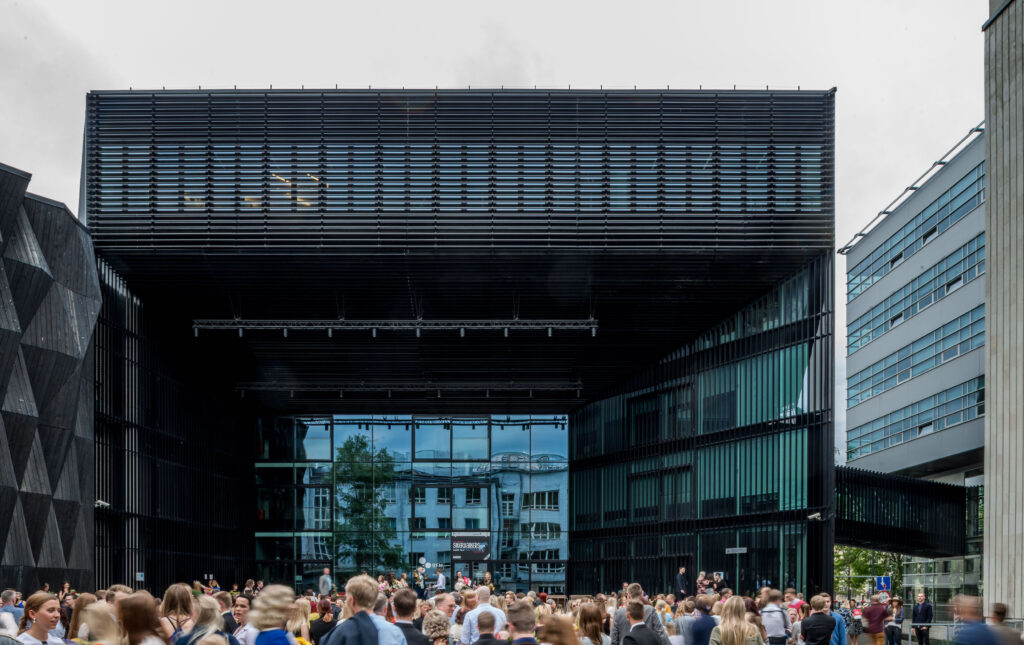
In this light, the most educational project for me has been the Baltic Film and Media School (BFM) building, which has taken a total of 11 years to complete. Tallinn University needed a study building, but we saw their main problem in the disorganised state of their campus and the gaping parking lot in the middle of their courtyard that prevented the space from being used in any sensible way. By designing the entrance area of the building as a stage opening toward the courtyard we hoped that the building would create an obvious need to remove the parking lot.
A later addition in the form of the Vita house tries to activate another part of the courtyard, creating a new circular traffic trajectory for the quarter. It also became possible to open a pass-through to Narva road—we are excited to see if collaboration with the neighbouring lot will ultimately create a working pedestrian street there. This is a good example of how it is possible to shape public understanding of space as a whole through a single building, and how function, that is, the necessity to build a house in the first place, is what provides the means to carry out the inevitable changes on a larger scale.

The Barge Society building in Tartu is another example of a lingering process where the project changed completely in the design phase—the original chic form ended up turning into something much more rustic.
The original version of the Barge Society building that we drafted in 2009 was so pompous that it would have actually been out of context in real-life settings. The Barge Society was very active and popular, yet it took a very long time for them to find the necessary funding for the building work and we had to cut back on the preliminary visions to such an extent that it just made more sense to begin from scratch. We made a modular project just in case, which could be built in stages or extended later on. Overall, it is a surprisingly good example of how stalling and rational proceedings resulted in a more adequate project.
Another one of your projects where a limited amount of means has been used to create an extremely strong presence is Fotografiska. That building is effortlessly metropolitan, somehow free from the wannabe-pretentiousness of our thin culture.
It is about the function as much as the form – an office building of a similar design would not be the same thing. The existence of a historical structure within it is also an important aspect, as is the idea of the rooftop square. But the focal concept of Fotografiska was the descending staircase ‘trunk’—on the one hand it is necessary for evacuation requirements, on the other, we were mainly intrigued by whether or not it would work as a ‘street’. It opens directly to the street—will people start using it as such? Sometimes it takes time for users to begin to realise the possibilities that a space offers. Art enables staging such things more easily, but in architecture it is more complicated—how can you create specific situations and add spatial value not required by the prescribed spatial programme because the client did not even think of asking for it? For example, we designed an outdoor auditorium for Tartu Kesklinna School, but for the first three years children were not allowed there because it was considered hazardous. Understanding and accepting spatial possibilities takes time. Some things might never begin to work, because if you only focus on granting the current wishes of the client, it becomes difficult to arrive at intriguing solutions. With a single-minded focus on a loft or an nZEB created in BIM, there can be no architectural evolution.

One of the biggest of such interventions has been Tallinn Cruise Terminal, designed together with Villem Tomiste from Stuudio Tallinn. The building itself takes up a rather small part of the project compared to the amount of public space that extends to the tip of the pier. At the client’s request, we designed gates along the promenade so it could be closed and partitioned in critical situations, but I sincerely hope the openness of that space in the middle of the closed parking landscape will work in reality. The length of the pier to-and-fro is 1.6 km, which is a terrific running strip supported by a restaurant, a children’s playground, seats with wind shades, and possibilities for the emergence of various pop-up establishments. Since the cruise terminal sits empty for eight months of the year, it made sense to create possibilities for renting or other types of exploitation; a promenade in public use will surely help to bring this object to public awareness.
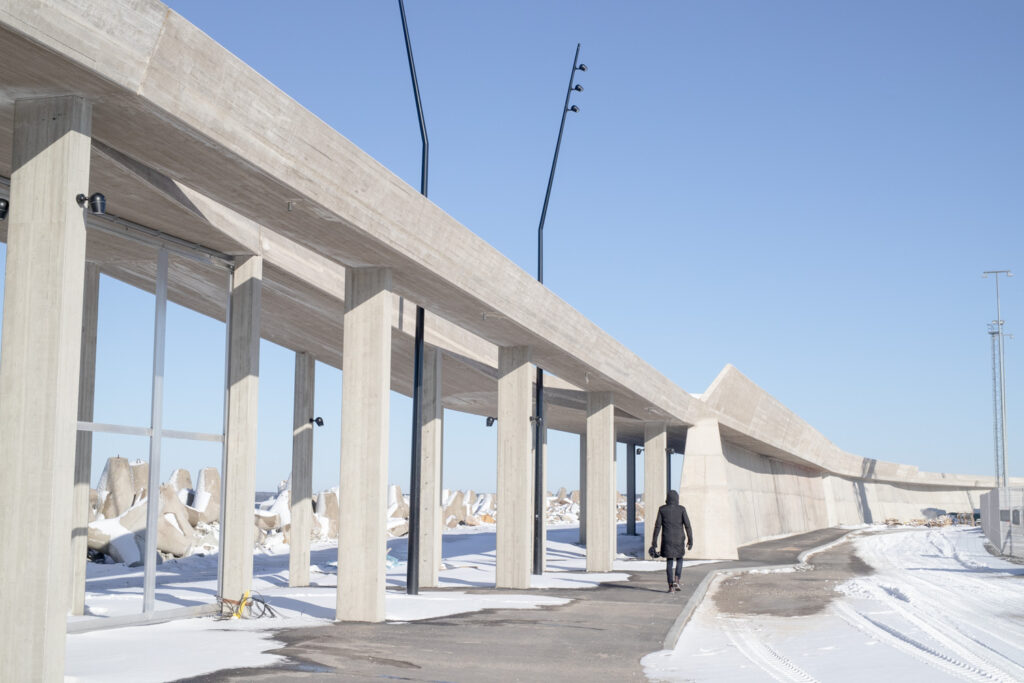
It seems like a fight where the architect is trying to create added value and greater openness while the world is trying to add more doors and situations where space could be subjected to more and more control. There seems to be a growing impulse for more security.
It is natural for a port to execute spatial control; the entire area is a security zone. The process has demanded a great deal of courage and stepping out of their comfort zone, which I highly appreciate.
More generally, though, I agree that over the last decade Estonian architecture has been greatly influenced by the emergence of a variety of microcontrol structures both in the procedures of the planning process as well as in the form of representatives from different areas of expertise, and this is by no means only an architecture-related problem. In a way it is motivating, because it demands that an architectural concept be exceptionally solid to pass through all those filters, but at the same time it can be tedious, largely unnecessary and tiring. The simplest way to get an idea of what I am talking about is to compare the volumes of the documentation of an architectural competition entry from 2005 to those from 2020.
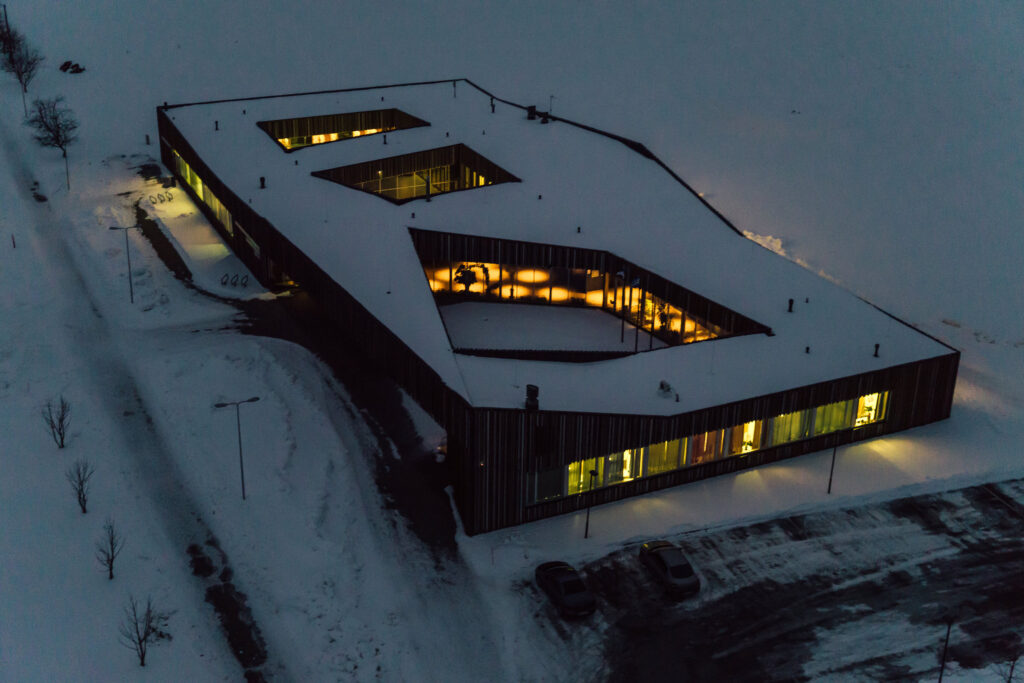
Is there something that is invariably significant for you in design, regardless of the type of assignment?
The Cruise Terminal continued some of the themes from BFM, there are ties to Fotografiska and installations, particularly ‘Heat Wave’. The latter was an installation on the banks of the river Seine in Paris where human movement would activate a panel with LED lamps and radiate infrared frequencies, touching upon the themes of urban security and accessibility as well as climate change. Ironically, the Seine began to overflow, and the installation had to be disassembled. The unifying aspect between all these projects is perhaps the thing that is most important to me in architecture—each of them is concerned with reclaiming the right to or control over an over-regulated or -standardised landscape or lot and rearranging the previously existing spatial hierarchies. ‘Heat Wave’ would heat outdoor air in a place that used to be one of the most popular sleeping areas for the homeless. An earlier installation, ‘Fast Track’, would take a high-voltage line in the forest, an infrastructure ignorant of the natural environment, and amplify its essence to a degree that morphed the spatial experience into an emotional one. We have done everything possible to sustain this delicate balance that would allow an architectural object to be described with a vocabulary similar to an installation; furthermore, to strive toward synonymy between the two. I am not referring to monumentality or sculpturality here, but a feeling of presence and intervening in a broader set of subject matters.
The Cruise Terminal made use of leftover land from infrastructure that could not be divided into parking spots. The purpose of Fotografiska was to connect the rooftop square and the public ground space via a street that was financed by a need for an evacuation stairway. Even the Estonian Road Museum, one of our earliest works, is still relevant to me because it takes the highly standardised road construction entity and reassembles it from fragments in a strange scale, creating something like a fun-house mirror from some children’s TV show that makes you experience the road in a completely new way.
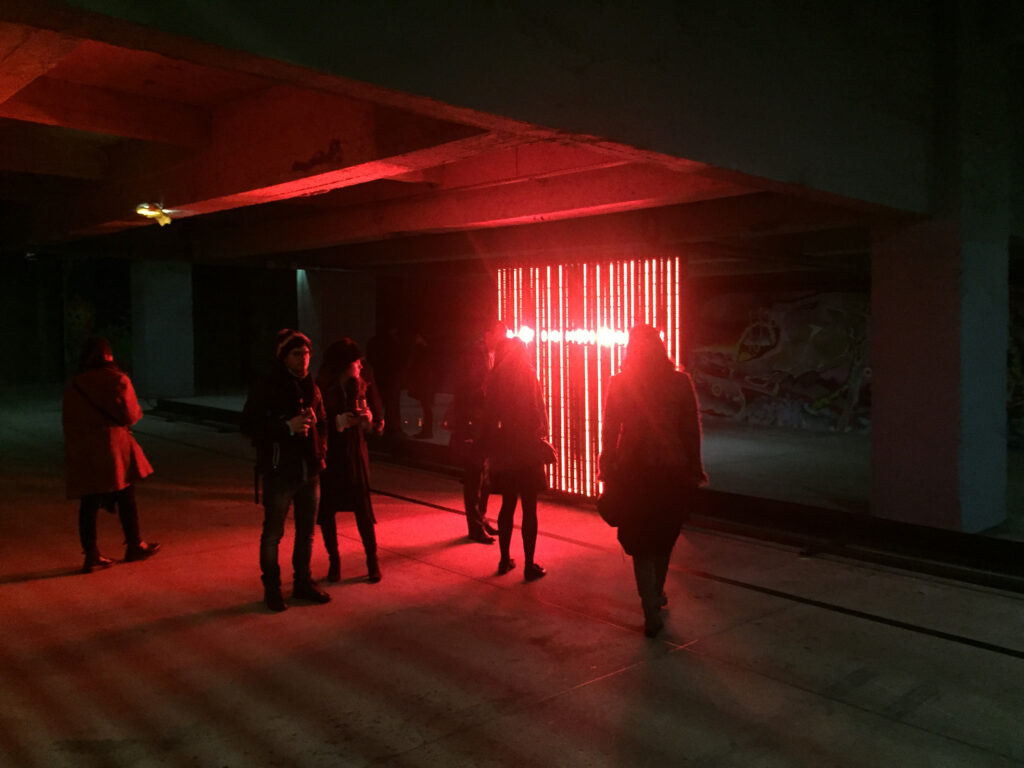
You have had a series of school projects in recent years, which seems like a very good chance to teach people to notice spatial qualities.
My own experience from Tallinn Secondary School No 7, where traditional classrooms were enmeshed with a success- and efficiency-oriented education model, was the impetus behind my interest in the school environment. An architect cannot change the curriculum or the general school system, but what we can do is create a school environment that would oppose the military mentality of the education system. Tartu Kesklinna School was the first reaction to my own school-related memories. Later school projects have been more about approaching the problem from the viewpoint of the natural qualities of the lot. For the user, landscape is more easily comprehensible than the building, so by creating strong links between the two our hope is that the users might better comprehend and appreciate the co-operation of the building and landscape. The school interior stems from interpretation of the lot and is easier to adopt to, as stress-free as possible and supportive of imaginative faculties. We may have taken this intent to create relaxing atmospheres even too far—Hannes Praks commented on the school in Viljandi by saying that it is the ‘best grill terrace in town’..

What would a liberating and experimental school be like?
The terms of reference for state high school competitions is our Viljandi State High School project because we put all activities that did not demand a closed classroom into the public space of the building. The ratio between open and closed spaces is 40-60 which means that there is a deliberate overproportioning of open space to enable hosting a variety of less formal activities. The entire learning experience is no longer confined within classrooms. However, this pattern has been in use for quite a while, it might be time to develop it further.
When preparing the concept for the International School of Tallinn, the headmaster who had arrived from the US proposed an even bolder experimental approach and try a solution with no walls at all. Estonian legislature does not allow that due to healthcare regulations. At the same time, we could test some alternatives. It seems that we worked out a great recipe with the Viljandi school project but in reality, it may have turned into a comfort zone by now. Building several state high schools has by now generated good competence in institutions such as the Ministry of Education and Research, and State Real Estate as well, but its full potential to think ahead from the current solutions and analyse all options from a fresh point of view has not been used. It could be done as a mere mental exercise to test different spatial configurations that would be even more absurd, simple, open, closed and what have you. Such experimenting cannot be integrated in competition proposals because you would not be awarded for it and it would not get you anywhere that way.
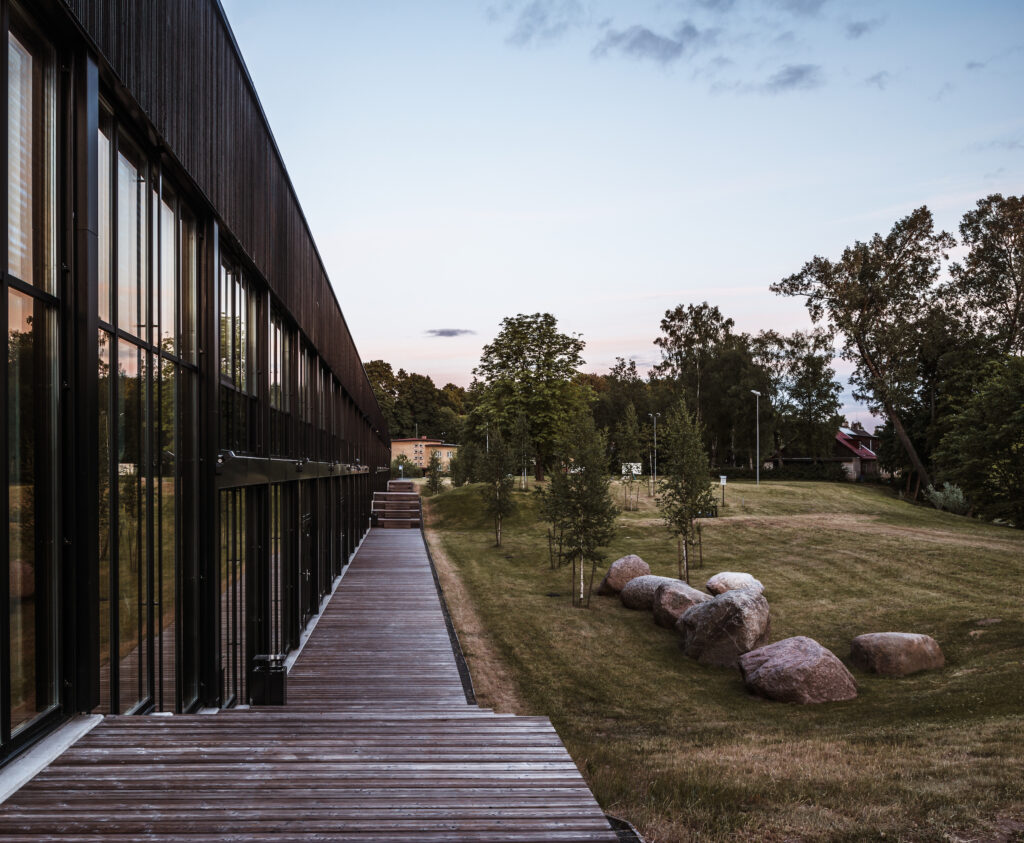
If an architecture competition is not the place for experimental or conceptual thought, then what is? Whose interest should it be to test ideas not readily applicable, who should be the initiator?
Architecture competitions lost their polemical role in Estonian society a long time ago, apart from perhaps the biggest international contests. In case of a normal competition it would have to be a very lucky coincidence where the client has an interest to find something new and a competition participant has taken the risk to think outside the limits of the prescribed scheme. It is very easy to fall into a comfort zone because a client representing public interest is always about minimising risk. So, when someone makes a radical competition entry that gets shoved aside immediately and noone ever exhibits it anywhere, then these experimental initiatives simply fade away.

In conjunction with new spatial solutions we cannot evade the question of whether or not the corona-experience will change architecture. Have you started noticing any changes in the expectations and needs of the client?
The main concern should be how we can use the situation to make things better. For example, in Finland the tendency has been to value economical solutions—the smaller the apartment, the better, as that means less of an ecological footprint to absolve. Lockdown quickly revealed that living in minimal conditions is challenging. Being locked into a hermetic cubicle just for the sake of lower utility bills ceased to make sense. The whole sustainability issue has been slightly misunderstood—instead of piling insulation layers on top of one another to build a box adhering to every norm it would make much more sense to fix something already existing that fosters spatial quality and would hold back on a great deal of building material. Corona should help us realise the value of quality. Confined to limited spaces such as home and office, the comfort level of these spaces becomes critical, all details become relevant. I’m not sure the most important aspect in such conditions is the energy efficiency of the building. On the contrary, it would feel nice to be able to open a window or step out onto the balcony; it is actually useful to not have every square metre optimised in advance.
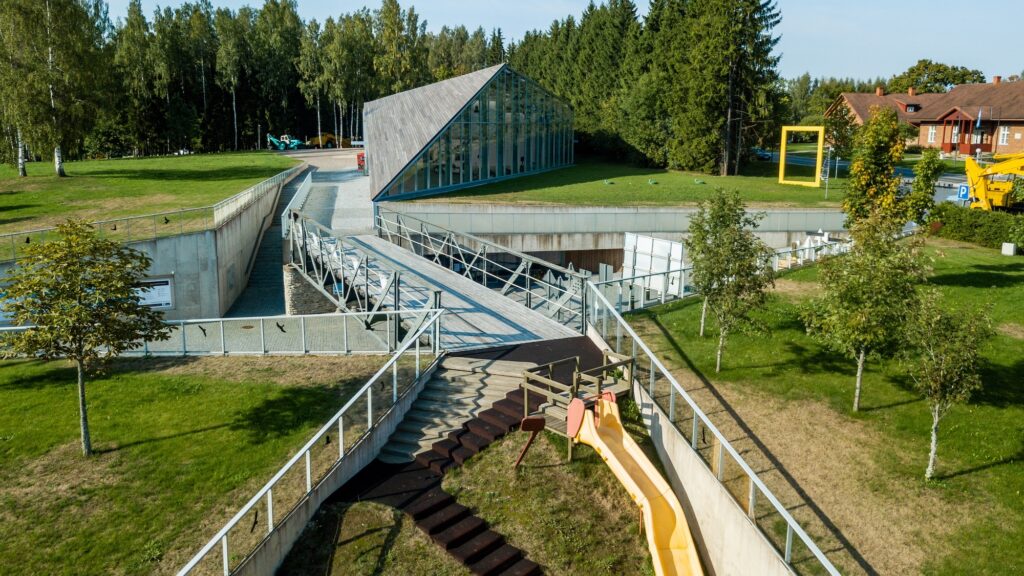
I sense you have never really been a technological enthusiast?
It is crucial to distinguish between a work device and the work itself. These intertwine up to a certain level, just as building materials do, but if a technical aid becomes an end in and of itself, then the result is likely to be just as uninteresting. I get the feeling it is a desire for some sort of a magic wand, be it nZEB, BIM, the rather forgotten smash hit of the day, i.e., parametric design, or, what video, rendering and computers in general used to be—people look for a goldfish to solve all their problems in the most convenient way.
Richard David Precht, proponent of universal basic income and robotic workforce, has described how in a future scenario everyone will have enough time for self-expression. I was interested in how he envisions the spatial disciplines. In his view, social workers and creative disciplines will survive, yet for him, the latter encompasses interior and landscape architects, but not actual architects. Maybe it is because in such a model, an architect is merely someone who grants the client his wishes and prescriptions, which the robot then formulates and proceeds, and the interior architect is left with the task to humanise the space.
As Alejandro Zaera-Polo once conceived—the architect will be left to decide which skin to pull over the box?
Yes, if that. That would effectively deprive the specialties of being a designer. It is definitely a remarkable tendency. Just like anyone can be an artist, author, musician and express their creativity, so do many people have wonderful architectural ideas they might want to experiment with. Since architecture is still too technical and complex, they will need an architect to formulate their ideas. Fortunately, this is not yet a rule and I would like to hope it will not happen in that way, at least not until I retire.

But how can you beat a robot?
In a sense you can’t. As long as there is an audience who appreciates a personal touch, some type of intrigue and discomfort, or open-ended situations where the ends don’t necessarily meet—for those people design is an enjoyment. But, in a quest for the optimal solution, I’m sure I have nothing over a robot.
Architecture obviously can not be a form of self-expression like pop music or poetry is, but something of that creative aspect should be preserved, some personal factor—an uncertainty perhaps, not thinking everything through to the final end.
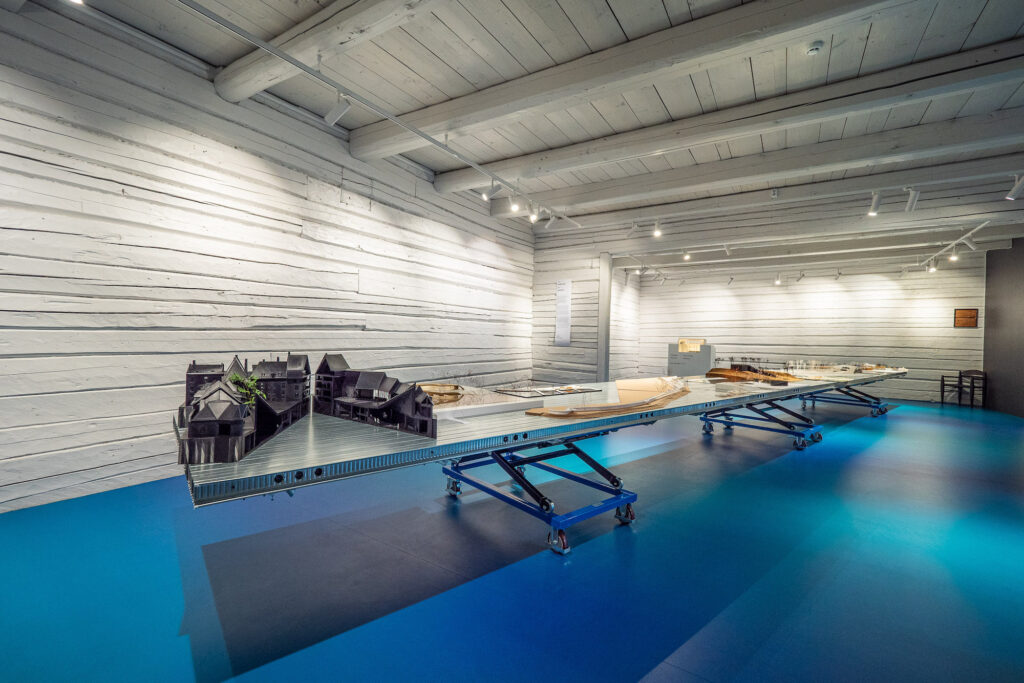
Is this personal factor somehow specifically local as well? Is there a way by which you can tell that something is namely Estonian architecture and not born in some other context?
An architect is always expected to give the right answers, to prove how his or her specific solution will make everything better and solve everyone’s problems. Compared to art, architecture is less interesting in that regard. Noone describes their building through the questions it arises, but through the problems it solves. But we have always emphasised that architecture can not always give a positive ’Yes!’ -answer to every single concern. As soon as more complex issues arise, the local aspect becomes extremely important. When you design to a foreign context, you do not know the local specificities, the unwritten rules. In such a situation the problem you set out to solve has to be so simple and banal that any more nuanced questions lose their meaning. This is where locality becomes relevant. Global corporate architecture is immensely simplifying because the question to which an exo-contextual architect can give a fast and proper answer must be neither specific nor complex.
In my view, living proof of this was when a slight shift occurred toward appreciation of locality upon RCR Arquitectes receiving the Pritzker Architecture Prize. Of course, you can be such a genius that you just get any foreign context, but success abroad should not be the only standard of measure for recognition. Estonian architects are probably able to learn to understand specificities in the contexts of our closest neighbours. Or design in star architecture style like all architects of the world. However, that share of the world that you can actually get to the bottom of is probably limited. In the end, the decisive factor is talent, you can build in any backwoods you can find.
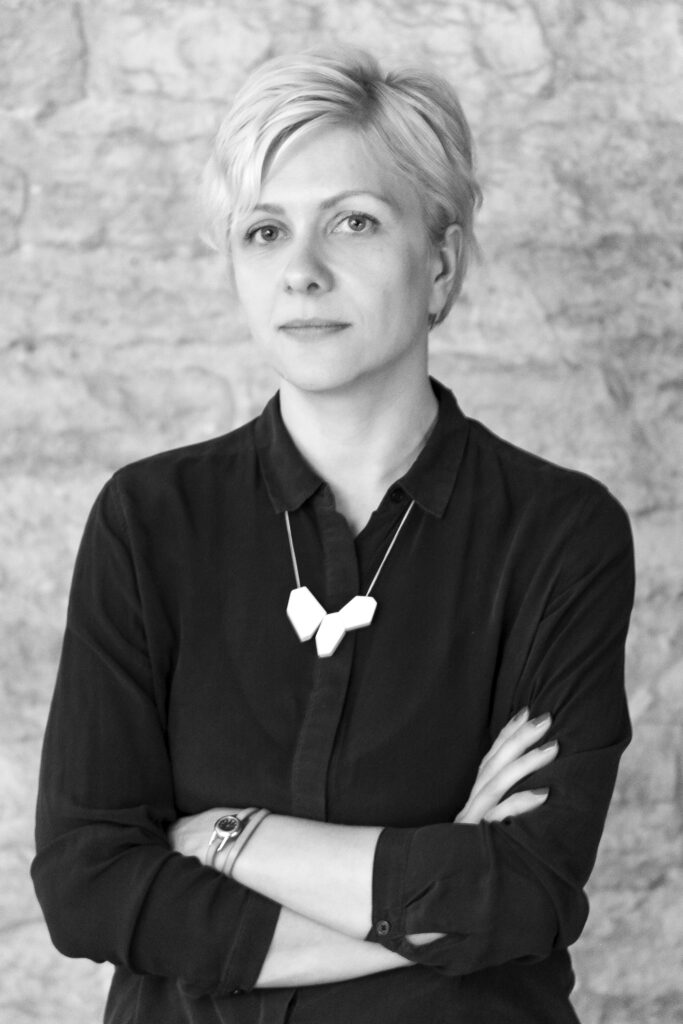
INGRID RUUDI is an architectural historian, critic and curator, researcher at the Institute of Art History and Visual Culture at the Estonian Academy of Arts.
HEADER: photo by Renee Altrov, graphic design by Margus Tammik
PUBLISHED: Maja 104 (spring 2021) What’s Happening?

